Nepean Patios: Best Materials for Ottawa Freeze-Thaw
Planning a beautiful new patio in Nepean? Ensure it stands the test of time against Ottawa's challenging freeze-thaw cycles by choosing the right materials and installation methods. Need expert advice or a quote? Contact Clean Yards today!
- Ottawa's freeze-thaw cycles are the primary cause of patio damage (heaving, shifting).
- A deep (12"+), properly compacted gravel base is essential for stability.
- Interlocking pavers and dense natural stone (like granite) are top material choices for durability.
- Proper installation, including drainage and edge restraints, is crucial.
- Avoid porous tiles, thin stones, or improperly installed concrete.
Introduction: Your Dream Nepean Patio vs. Ottawa's Wild Weather
Ah, the dream Nepean patio! Picture this: lounging in comfy chairs on a warm evening, the BBQ sizzling nearby, maybe surrounded by colourful container gardens adding a splash of life. It’s your perfect summer escape, right in your own Nepean backyard, maybe even rivalling those beautiful setups you see in nearby Barrhaven. It's the heart of your outdoor living space, the stage for countless happy memories.
But wait! Before you get *too* lost in that lovely daydream, let's chat about the uninvited, slightly grumpy party guest that shows up every year: Ottawa's wild weather. Specifically, our infamous freeze-thaw cycle. Think of it as Mother Nature’s little prank on our landscaping plans – freezing the ground solid in winter, then thawing it out come spring, sometimes multiple times! For more insights on preparing your yard for seasonal changes, check out our about us page and see how we approach local landscaping challenges.
This constant expansion and contraction of the soil and moisture beneath your patio is the number one reason patios heave, crack, and shift. Suddenly, your perfectly level oasis can start looking like a miniature, lumpy landscape itself. Don't despair, though! Understanding this challenge is the *key* first step. Knowing how to properly prepare the base and choose the right materials for our unique Ottawa climate is the secret to building a dream patio in Nepean that not only looks fantastic but also stands strong against the weather's shenanigans for years to come. Let's make sure your investment endures!
The Freeze-Thaw Foe: Why Ottawa Winters Wreak Havoc on Patios
Okay, let's pull back the curtain on Ottawa's winter villain, the sneaky force that can turn your perfect patio into a bit of a puzzle: the freeze-thaw cycle. Think of it as Mother Nature playing a game of push-and-pull with the ground beneath your feet, especially during our wild Ottawa winters and unpredictable springs.
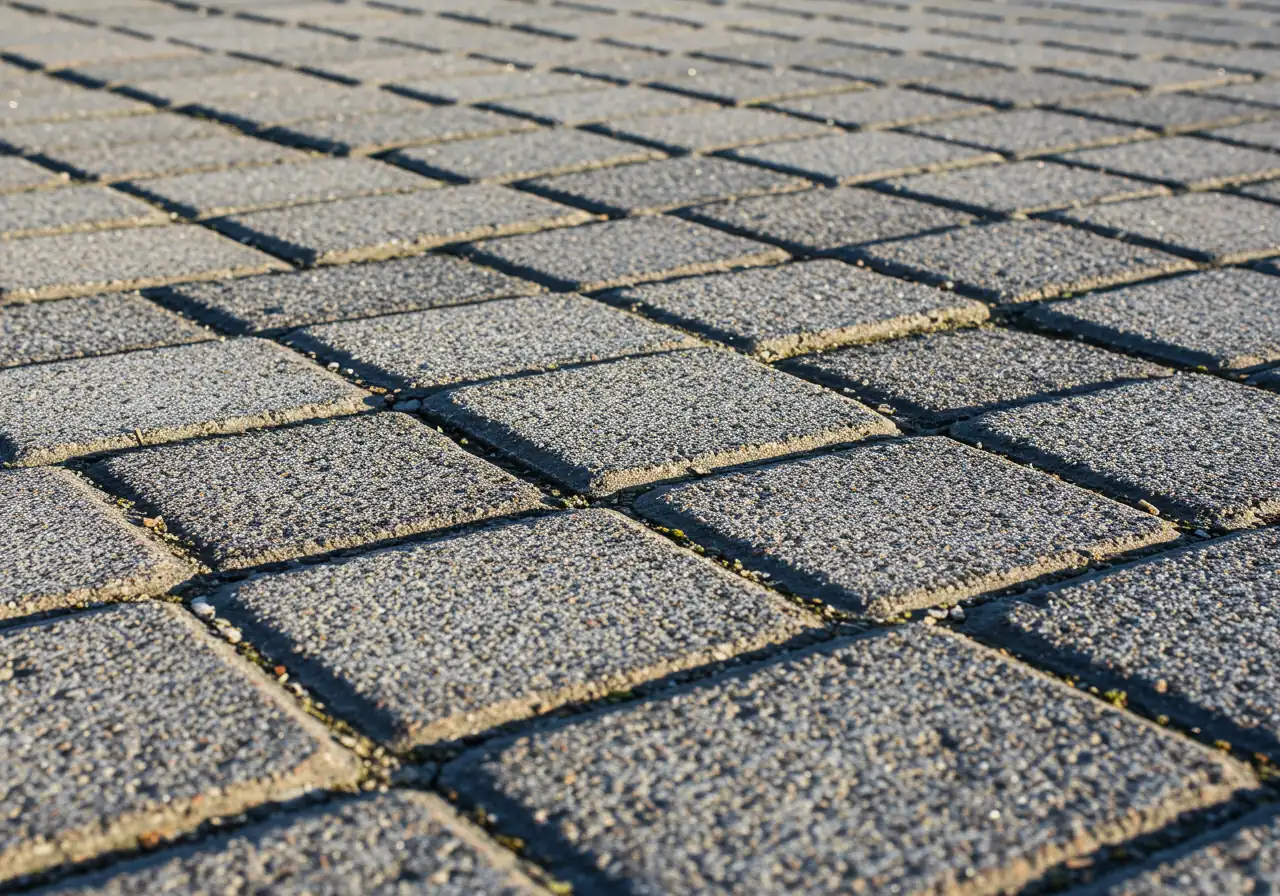
Here’s the lowdown:
Water is the main character in this chilly drama. Throughout the fall and even during winter thaws, water naturally seeps into the ground – into the soil and the gravel base beneath your patio stones or pavers. This happens all over Ottawa, from Kanata to Orleans, and even in areas with heavier clay soil like parts of Greely, which can hold onto moisture really well. You might find tips on managing soil moisture in our soil preparation guide.
Now, when the temperature plummets below freezing (which, let’s face it, is most of an Ottawa winter!), that trapped water turns to ice. Here's the kicker: water *expands* when it freezes, by about 9 percent! It might not sound like much, but this expansion exerts incredible force, pushing the soil, gravel, and your patio *upwards*. This is called frost heave. Imagine tiny, invisible jacks lifting sections of your patio. Find us on Google Maps to see our service area covering these conditions.
Then, inevitably, temperatures rise above zero. Maybe it’s a mid-winter thaw, or the arrival of spring. That ice melts, the water shrinks back, and the ground settles down again. The problem? It rarely settles back perfectly evenly. Some spots might sink lower than others.
Repeat this cycle – freeze, expand, push up; thaw, shrink, settle down – multiple times over a single winter and spring season, and you can see why patios start to look uneven. You get pavers popping up, stones sinking, creating annoying lips and bumps that are trip hazards and just plain don't look good. Poor drainage around the patio makes it worse, allowing more water to collect near the base. Ensuring good drainage is part of overall yard health, something to keep in mind when doing your annual Nepean Fall Garden Health Checks. Similarly, managing water near your patio is as critical as preparing your plumbing; remember that effective Nepean Irrigation Winterization Avoids Pipe Damage by controlling water in freezing conditions.
When spring *finally* arrives for good, you might survey the damage. This seasonal check-up is just as important for your hardscaping as dealing with soil compaction is for your grass – considering Nepean Spring Lawn Aeration Ottawa can be part of your overall spring yard assessment, including checking patio levels. Proper lawn care contributes to overall yard drainage.
So, what’s the secret weapon against this freeze-thaw foe?
- A Super Strong Base: A deep (we're talking *deep* – often 12 inches or more for Ottawa!) layer of properly compacted gravel is essential. This allows water to drain away *below* the frost line and provides a stable foundation that resists movement.
- Good Drainage: Sloping the patio itself slightly, and grading the surrounding soil away from the patio edge, prevents water from pooling near the base. This is a key consideration during landscaping and part of smart Nepean Fall Garden Prep Colour Winter Tips.
- Quality Materials: Using pavers or stones designed to withstand our harsh climate helps too.
Building a patio that lasts in Ottawa, whether you're in Nepean, Barrhaven, or Manotick, means planning for this freeze-thaw cycle from the very beginning. If your existing patio has fallen victim to winter's heaving habits, professional help can often correct the issues. Exploring professional Landscaping and Yard Care Services can provide solutions for repair or ensure a new installation is built right the first time. This includes general property clean up to prepare the area.
Patio Wars: The Best Material Contenders for Nepean Conditions
Okay, team, let's dive into the main event: the Patio Wars! We know Ottawa's weather, especially that pesky freeze-thaw cycle, throws down a serious gauntlet for our beloved outdoor spaces in Nepean. Choosing the right material isn't just about looks (though that's important too!); it's about picking a champion that can go toe-to-toe with winter and still look great come spring. So, grab a ringside seat, and let's meet the top contenders vying for the title of "Best Patio Material for Nepean Conditions."
Contender #1: Interlocking Concrete Pavers
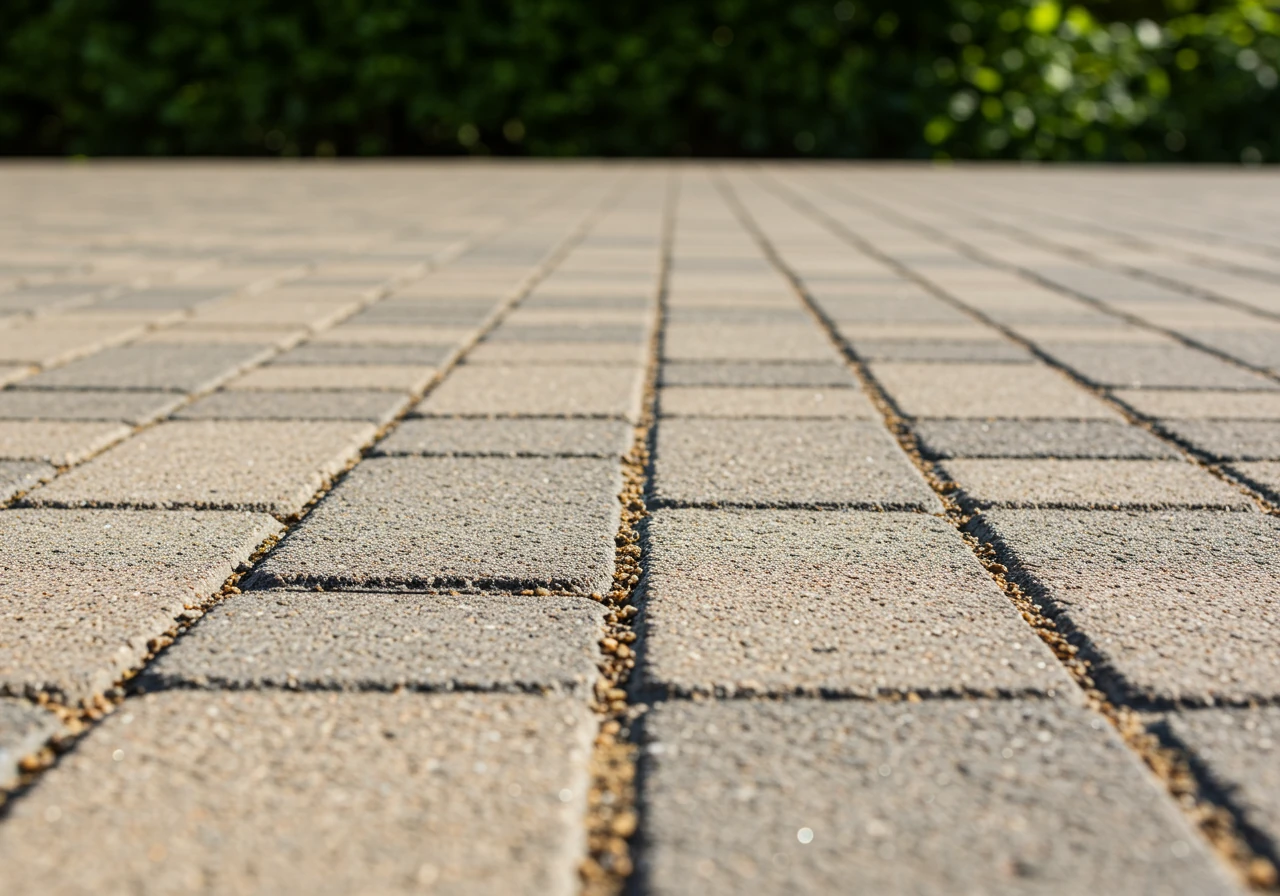
Think of pavers as the adaptable all-stars of the patio world. They come in a dizzying array of shapes, sizes, colours, and textures, making it easy to match your home's style, whether you're in a newer Barrhaven development or a more established Nepean neighbourhood.
Pros:
- Variety Show: Seriously, the design possibilities are almost endless.
- Tough Cookies: High-quality concrete pavers are manufactured to be dense and durable, handling foot traffic and patio furniture like champs.
- Flexibility is Key: Because they are individual units, pavers can shift *slightly* with minor ground movement without major cracking. If one gets damaged or badly stained, you can often replace just that single paver – much easier than patching concrete!
- Freeze-Thaw Fighters: When installed correctly over a *deep*, properly compacted base, pavers perform exceptionally well in our climate. The joints allow for tiny movements.
Cons:
- Base is Boss: The biggest weakness? A poorly prepared base. If the foundation isn't deep and compacted enough, pavers *will* heave and settle unevenly. Proper Soil Preparation is non-negotiable here.
- Joint Duty: The sand-filled joints need occasional topping up (using polymeric sand helps lock them in and deter weeds) and can sometimes allow weeds or moss to sprout if not maintained. Regular maintenance might include sweeping and occasional rinsing, tasks sometimes bundled with a Nepean Yard Cleanup Service.
Nepean Verdict: A crowd favourite for good reason. Excellent choice if installed properly. Don't skimp on the base prep!
Contender #2: Natural Stone (Flagstone, Granite, Limestone)
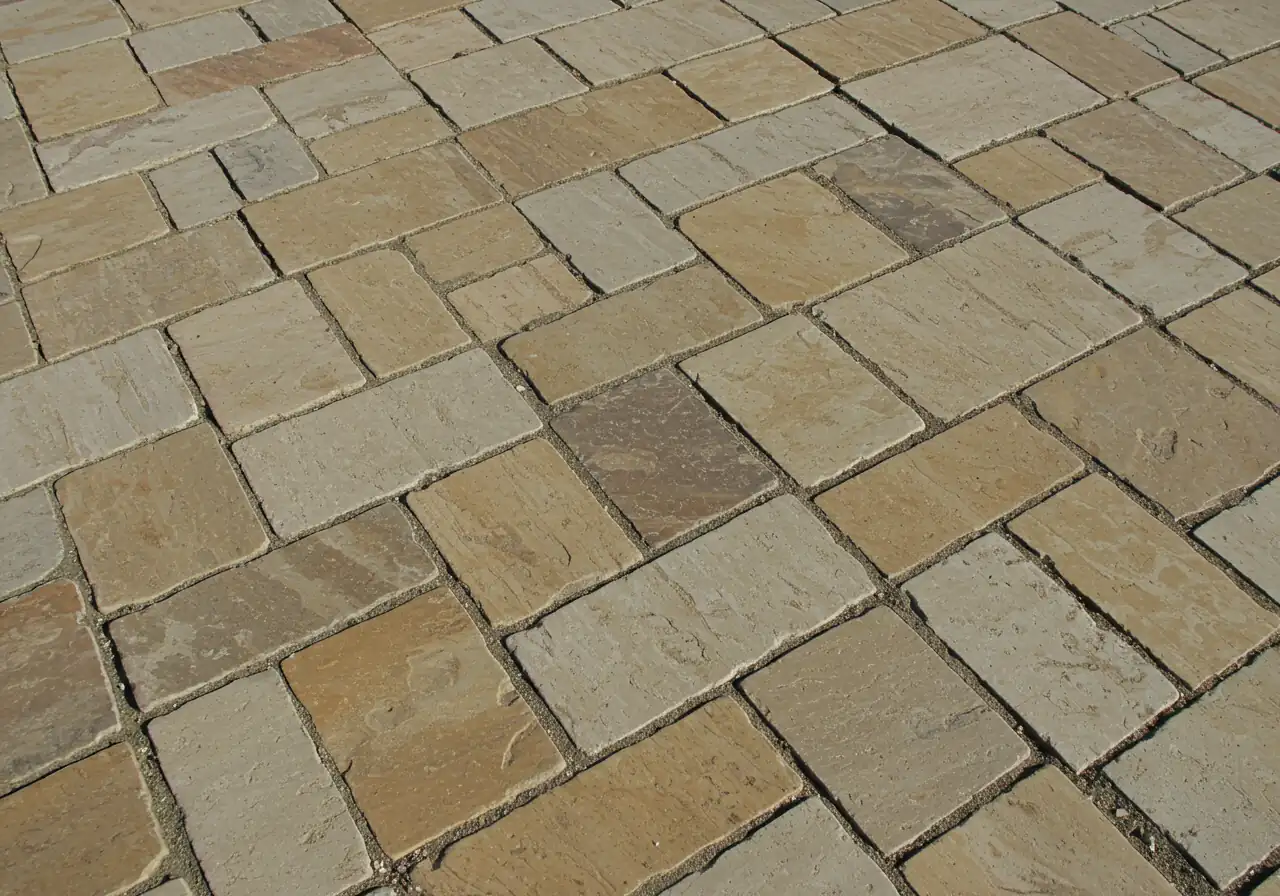
For timeless beauty and undeniable character, natural stone is the heavyweight champion. Flagstone (like limestone or sandstone often used) offers rustic charm, while granite brings unbeatable toughness and a more uniform look.
Pros:
- Naturally Gorgeous: Each stone is unique, creating a one-of-a-kind, high-end look that complements landscaping beautifully, especially fitting for properties aiming for a classic feel, perhaps like some you'd find in Manotick or Richmond.
- Built to Last (Mostly): Granite is incredibly hard and resistant to wear and weather. Good quality flagstone is also very durable.
- Investment Value: Adds significant aesthetic and potential resale value to your home. Check out some backyard transformations featuring natural stone.
Cons:
- Pricier Punch: Natural stone typically costs more than concrete pavers, both for the material and the more labour-intensive installation.
- Installation Intensity: Irregular shapes (especially flagstone) require skilled installation for tight joints and a level surface. A deep, solid base is just as crucial as with pavers.
- Potential Pitfalls: Some stones (like softer limestones) can be more susceptible to flaking (spalling) over many freeze-thaw cycles if they absorb too much water. Sealing can help. Some surfaces can be slippery when wet.
Nepean Verdict: A premium choice offering unparalleled beauty. Best suited for those with a larger budget who prioritize natural aesthetics and long-term durability (especially with granite). Ensure you choose stone suitable for our climate. Getting quotes? Check out our Estimate Feedback page to see what others say about the process.
Contender #3: Poured Concrete
The straightforward, no-nonsense contender. A poured concrete patio is essentially one large slab, often seen as a budget-friendly starting point.
Pros:
- Wallet-Friendly (Initially): Generally has a lower upfront installation cost compared to pavers or natural stone.
- Surface Versatility: Can be finished smooth, brushed for texture, or even stamped and coloured to mimic stone or brick.
- Solid & Stable (When New): Provides a very even, solid surface initially.
Cons:
- Crack Attack: Concrete's biggest enemy in Ottawa is cracking. While control joints help direct cracks, the freeze-thaw cycle puts immense stress on a large slab, making cracks almost inevitable over time.
- Repair Woes: Repairing cracked concrete is difficult. Patches rarely match perfectly and can look obvious. Major damage might require replacement.
- Potential for Spalling: Surface flaking (spalling) can occur due to freeze-thaw action, especially if the concrete mix or finishing wasn't perfect or if de-icing salts are used heavily.
Nepean Verdict: A viable option, especially for budget-focused projects or utility pads, BUT only if installed *expertly*. This means a super-strong base, proper reinforcement (like rebar or wire mesh), air-entrained concrete mix suitable for cold climates, and well-placed control joints. Given the cracking risk, it might not offer the best long-term value compared to well-installed pavers in our specific climate. When hiring for such critical work, always review the company's Terms and Conditions regarding workmanship and materials.
Choosing your patio champion depends on your budget, style preferences, and tolerance for maintenance. However, the *undisputed* requirement for any long-lasting Nepean patio is meticulous base preparation. Skimp here, and even the toughest material will eventually succumb to the freeze-thaw foe. Considering professional installation? Explore various Landscaping and Yard Care Services to find experts familiar with Ottawa's unique challenges.
Note: Resistance highly dependent on proper installation base.
Use With Caution: Materials That Might Crack Under Pressure (Literally!)
Alright, let's chat about the materials that might look tempting for your patio project but tend to throw a bit of a tantrum when faced with Ottawa's dramatic freeze-thaw cycle. Choosing the wrong contender can lead to cracks, chips, and a general look of dismay faster than you can say "frost heave." Think of this as a friendly heads-up to help you dodge potential landscaping pitfalls, saving you time and future repair bills, whether you're in bustling Nepean or quieter spots like Metcalfe, where specialized services like Metcalf Yard Cleanup Service might be relevant for general tidiness.
Here are a few materials that often don't play nicely with our winter weather:
- Standard Indoor Ceramic or Porcelain Tile: We know, we know – they come in gorgeous patterns! But tiles designed for your kitchen floor are *not* built for the great outdoors here. They are often too porous (meaning they absorb water easily) or too brittle to handle the expansion and contraction that comes with freezing. Water gets in, freezes, expands, and *pop* goes the tile! Cracking and surface damage are almost inevitable.
- Thin or Highly Porous Natural Stone: While we sang the praises of *suitable* natural stone earlier, be wary of thinner flagstones (especially some slates or sandstones not rated for cold climates). If they absorb too much water, they can suffer from *spalling*. That’s a fancy word for the surface layers flaking or peeling off after being frozen. It's not a good look, and it weakens the stone over time. Always ask if a natural stone is rated for freeze-thaw conditions!
- Untreated or Soft Woods Laid Directly on Ground: While wood *decks* are great, laying untreated wood sleepers or planks directly on a gravel or sand base as a patio surface is asking for trouble. Ground contact invites moisture and rot, and the freeze-thaw cycles will cause significant warping, shifting, and decay.
- Basic Clay Building Bricks: The common bricks used for house walls are generally too absorbent for patio surfaces that will endure constant moisture and freezing. They can crack, crumble, or spall. Look specifically for *clay pavers*, which are fired at higher temperatures to be much denser and less porous.
Even with diligent base work, including careful Soil Preparation, these materials have inherent weaknesses that make them risky investments for an Ottawa patio. Keeping the surrounding area tidy helps manage moisture – something a service like the Metcalf Property Cleanup Service can assist with – but it won't magically make unsuitable materials frost-resistant. Similar care applies to nearby garden beds; ensuring they drain properly and are kept tidy, perhaps with help from a Metcalf Garden Clean Up Service, prevents excess water pooling near your patio edge. If you're starting fresh and need significant clearing, tackling that first is key, a task that services like the Marionville Property Cleanup Service handle in nearby areas. When consulting with any service provider, it's good practice to understand how they handle your information; you can see our approach in our Privacy Policy.
Bottom line? Stick with materials proven to withstand our climate’s challenges for a patio that brings joy, not frustration!
It's All About That Base: Why Installation Matters More Than You Think
Okay, let's dig into the nitty-gritty! You've picked out gorgeous pavers, dreamed up the perfect layout for your Nepean oasis, and mentally placed the BBQ. Awesome! But hold your horses (or should we say, hold your patio stones?) because choosing the *right* material is only half the battle. The real secret weapon against Ottawa's wild weather and for a patio that lasts? It's all about that base, baby! Seriously, installation matters *way* more than most people think.
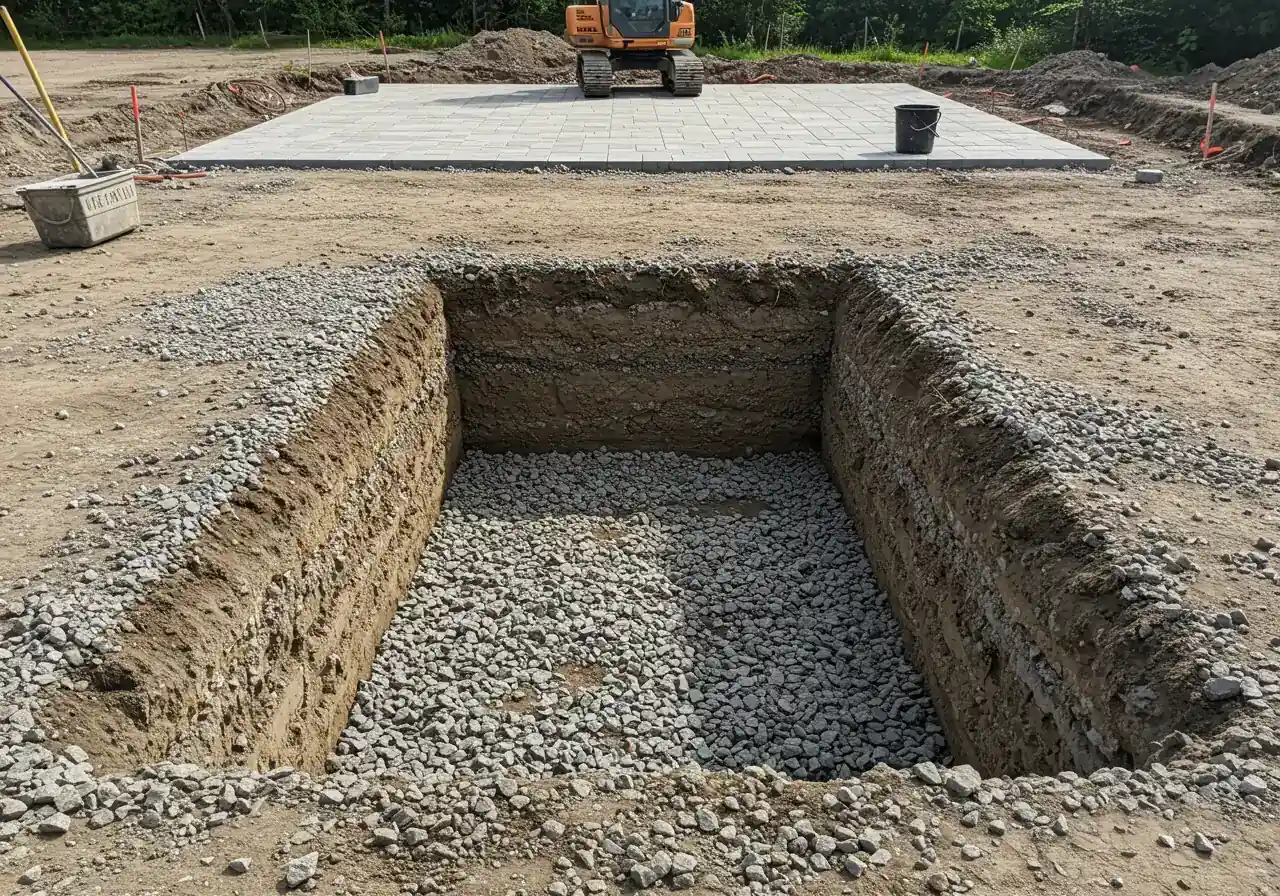
Think of it like baking a magnificent cake. You can have the finest Belgian chocolate and organic flour (your fancy pavers), but if you forget the baking powder or mess up the oven temperature (the base and installation), you're gonna end up with a sad, flat pancake instead of a showstopper. In the patio world, a poor installation leads to heaving, sinking, and tripping hazards faster than you can say "frost heave."
So, what makes for a *proper* installation, especially here in Ottawa?
Key Installation Steps:
1. Excavation
Dig deep! Remove topsoil and organic matter to reach stable subsoil. Depth needs to accommodate the full base layer (12"+), bedding sand, and paver thickness.
2. Base Material (Aggregate)
Add granular 'A' (0-3/4" crushed stone) in layers (lifts) of 4-6 inches. Compact each layer thoroughly with a plate tamper. This is the critical step for stability.
3. Geotextile Fabric (Optional but Recommended)
Place fabric between subsoil and base gravel to prevent mixing and improve stability, especially on clay soils.
4. Bedding Sand
Spread a uniform 1-inch layer of coarse concrete sand over the compacted base. Screed it perfectly level – this determines the final smoothness.
5. Edge Restraints
Install sturdy restraints (plastic, metal, concrete) around the perimeter, secured into the base with spikes. This locks pavers in place.
6. Laying Pavers
Place pavers gently onto the sand bed according to your pattern. Work from a corner outwards. Avoid sliding them. Cut pavers as needed for edges.
7. Compaction & Jointing
Compact the pavers into the sand bed using a plate tamper (with a protective pad). Sweep polymeric sand into the joints, compact again, sweep off excess, and activate with a light mist of water.
- The Mighty Base: This is the heavyweight champion of patio longevity. Forget scraping off a few inches of grass and throwing down some sand. In our climate, you need a *deep* foundation – we're talking typically 12 inches or *more* of compacted granular aggregate (like 0-3/4" crushed stone). Why so deep? It gets below the squishiest part of the soil and provides a stable layer that allows water to drain *away* before it can freeze and heave your patio upwards. Compaction is key, too – done in layers (lifts) to ensure maximum density and stability. Skimping here is the #1 patio fail. If your yard needs significant clearing before excavation even starts, services like a Ottawa Property Cleanup Service can handle the initial heavy lifting.
- Drainage, Drainage, Drainage: Water needs to go somewhere, and you definitely don't want it pooling on or under your patio. Proper installation includes sloping the patio surface *slightly* (usually about 1/4 inch per foot) away from your house foundation. The surrounding soil should also be graded to direct water away. This is crucial for preventing water saturation near the base, which is the fuel for the freeze-thaw fire. Good drainage around your patio also benefits nearby plants, linking into overall good Garden Maintenance practices.
- Edge Restraints: The Unsung Heroes: These are rigid borders (often plastic, metal, or concrete) installed around the perimeter of the paver area, anchored securely into the base. What do they do? They lock everything in place, preventing the pavers from shifting outwards over time – kind of like how proper edging defines a garden bed. Without them, your patio edges can start to look loose and uneven. This complements other tidy landscaping efforts, like sharp lines achieved through Mulching and Edging.
- Jointing Compound (Polymeric Sand): Those little gaps between pavers need filling! Using polymeric sand is highly recommended. When activated with water, it hardens, locking the pavers together, deterring weeds and ants, and resisting washout from rain much better than regular sand.
Seasonal Tip: Once the spring thaw is complete, take a walk around your patio. Look for any pavers that have slightly shifted or areas where the joint sand might need a top-up. Catching small issues early prevents bigger problems down the road. Keeping the area clean also helps, whether through DIY efforts or an occasional professional City Yard Cleanup Service. For specific garden related tidying near the patio, consider a City Garden Clean Up Service.
Building a patio base correctly is hard work and requires specific knowledge, especially regarding our local soil conditions in places like Nepean, Barrhaven, or even out towards Greely. Hiring qualified local professionals who understand Ottawa's freeze-thaw cycle is often the best investment. They have the equipment and expertise to ensure that base is deep, compacted, and graded correctly, giving your beautiful patio the foundation it deserves. Remember to factor in final site tidiness; a service like the Marionville Yard Cleanup Service can ensure everything looks pristine post-construction in neighbouring areas.
Eco-Conscious Patios: Sustainable Choices for Greener Nepean Yards
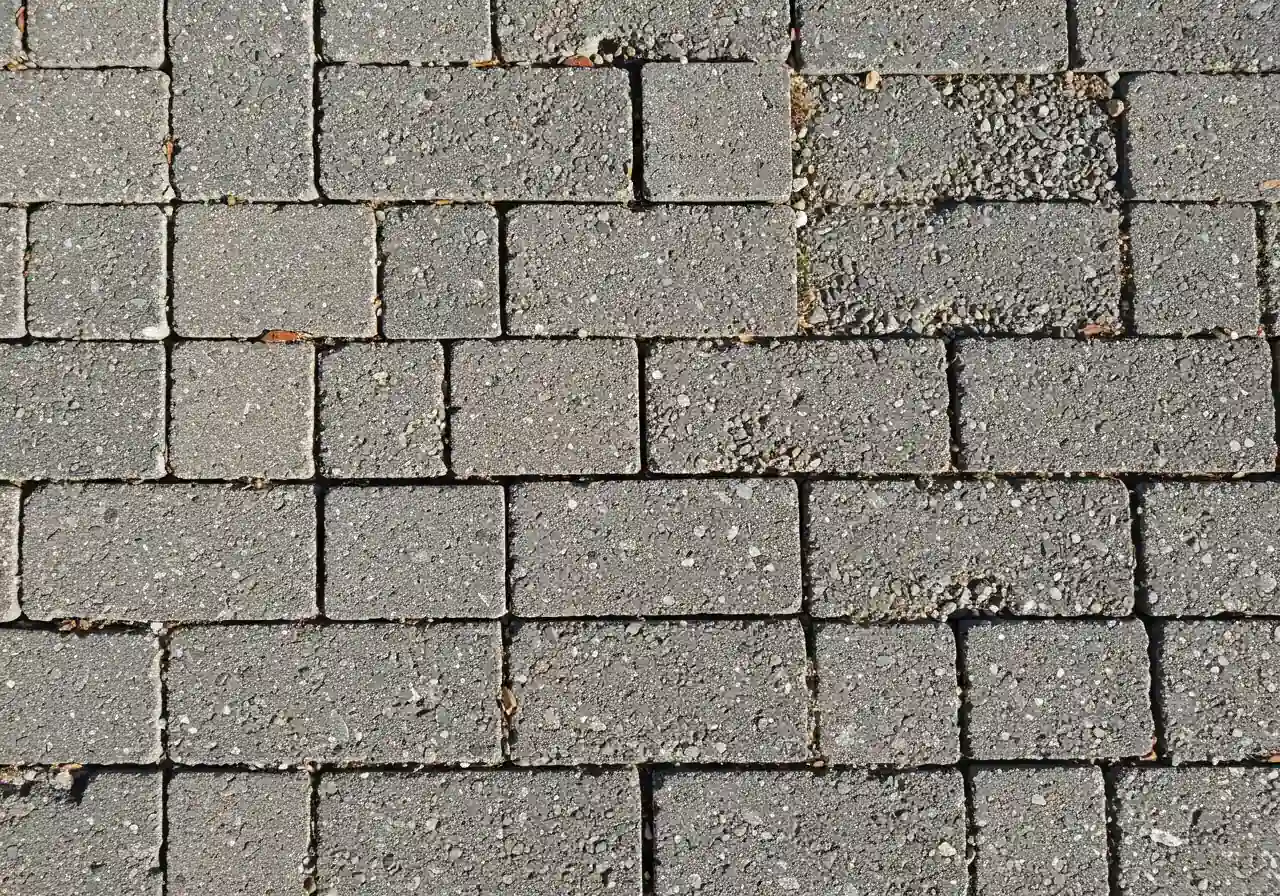
Thinking about a new patio but want to be kind to Mother Earth? High five! Creating an eco-conscious outdoor space in your Nepean yard is easier than you might think, and it comes with some pretty neat benefits beyond just feeling good. It’s all about making smarter choices that work *with* nature, not against it – something we see homeowners increasingly value, from established Ottawa neighbourhoods to growing communities like Russell and Embrun.
One of the star players in the green patio game is *permeable pavers*. These clever stones look much like traditional pavers but are designed with larger gaps between them, or are made from porous material themselves. Laid on a special base, they allow rainwater to soak right through into the ground below instead of running off into storm drains. Why is this awesome? It reduces surface runoff (goodbye, giant puddles!), helps recharge groundwater, filters pollutants naturally, and can even lessen the load on municipal storm systems (check Rain Ready Ottawa for related city initiatives). Keeping the areas around your patio clean is also important for managing water; regular upkeep, maybe handled by an Ottawa Garden Clean Up Service, prevents debris from blocking drainage.
Another great eco-move is choosing *locally sourced materials*. Think natural stone quarried right here in Ontario or nearby Quebec. Opting for local means less transportation fuel is burned getting the materials to your Nepean home, shrinking the carbon footprint of your project. Plus, you're supporting regional businesses! Combining these materials with smart landscaping can lead to stunning results; check out some inspirational Backyard Design Transformations for ideas. For information on local conservation areas and green spaces, the National Capital Greenbelt offers great resources.
Maintaining these eco-features is key. For permeable pavers, occasional sweeping or gentle washing helps keep the joints clear so water can filter through – it's a bit like routine City Garden Maintenance Service but for your patio! Proper installation often involves specific base preparation, sometimes requiring significant initial tidying, similar to the work done by a Metcalf Property Cleanup Service before major landscaping. Even starting the project might mean clearing existing clutter, a task sometimes handled by a broader Ottawa Yard Cleanup Service. By choosing sustainable options, your Nepean patio can be beautiful *and* beneficial for the environment. Always check local weather forecasts from sources like Environment Canada for Ottawa when planning outdoor work.
Key Insights: Freeze-Thaw Patio Wisdom
So, you want the cheat sheet for a patio that won't quit after a few Ottawa winters? You got it! Here are the absolute must-knows:
- Respect the Freeze-Thaw Force: Don't underestimate Mother Nature's ability to push things around! The expansion and contraction of freezing water *under* your patio is the main villain. Acknowledging this is Step One to building smart.
- Base is King (Seriously): Forget fancy top layers if the foundation is weak. A deep (think 12 inches or more!), properly compacted gravel base is *crucial* in our region. It provides stability and drainage below the frost line. Skimping here is the most common, and costly, mistake. Proper site prep is essential; sometimes clearing the way requires significant effort, like the work handled by a City Property Cleanup Service for larger-scale projects.
- Material Matters – Choose Wisely: Opt for materials designed to withstand our climate. Dense interlocking concrete pavers or durable, low-absorption natural stone are generally safer bets than porous tiles or standard bricks. Think long-term value and resilience – the right materials complement your whole yard, including vibrant plantings from a professional Garden Install.
- Drainage & Details Prevent Drama: Ensure your patio slopes gently *away* from your house to shed water effectively. Use proper edge restraints to keep pavers locked in place. Correct installation manages water flow, protecting the patio base and integrating well with surrounding landscaping, like ensuring proper grading for healthy grass after Sod Installation. Keeping adjacent garden beds tidy is also part of the picture; preventing debris buildup that traps moisture, perhaps with occasional help from a service like the Marionville Garden Clean Up Service, supports your patio's longevity. Get these details right, and you'll avoid headaches later – we always appreciate hearing success stories, check out our Thank You page for feedback from satisfied clients!
Focus on these core principles, and you'll be well on your way to a beautiful, durable Nepean patio that can handle whatever Ottawa's weather throws its way.
Nepean Patio FAQs: Your Freeze-Thaw Questions Answered
Don't panic! Uneven pavers are a classic sign of frost heave, very common here in Ottawa. Often, the individual pavers are fine. The fix usually involves lifting the affected section, correcting the base underneath (adding and re-compacting gravel), and re-laying the pavers. It’s less disruptive than a full replacement but crucial for long-term stability. This type of repair might fall under general property clean up or specific hardscape repair services.
We know it sounds like a lot, but for our freeze-thaw conditions, a base depth of 12 inches (30 cm) of compacted granular 'A' gravel is the standard recommendation. This provides a stable foundation below the typical frost line, allowing water to drain and minimizing that upward push when the ground freezes. Skimping here almost guarantees future problems. Clearing space for this level of excavation might require a thorough Ottawa Property Cleanup Service first.
Sealing can offer protection against stains and potentially reduce water absorption, which helps fight freeze-thaw damage like spalling. However, use a *breathable* sealer specifically designed for pavers. Non-breathable sealers can trap moisture underneath, potentially worsening issues. Test in an inconspicuous spot first, and reapply according to manufacturer directions, usually every few years.
While you *can* sweep in regular sand, it's usually a temporary fix that washes out easily. For a much better result in our climate, use polymeric sand. It hardens when activated with water, locking pavers together, resisting washout, and deterring weeds and ants much more effectively. Keeping the patio edges clear with regular maintenance, maybe like a City Garden Clean Up Service, helps keep joints intact longer too.
It can if not planned carefully! Garden beds retain moisture. Ensure the soil slopes *away* from the patio edge and that your patio has a solid edge restraint. Consider a gravel drainage strip between the garden and patio. Proper planning integrates your hardscaping and softscaping beautifully; if you're adding new beds, think about a professional Garden Install that considers drainage.
Winter debris accumulation is common! A tidy border enhances your patio area. Besides your own efforts, professional help is available. For issues extending to the municipal edge of your property, consider looking into a specialized City Property Cleanup Service to handle debris and leaves that might blow onto your patio or clog drainage. For broader yard tidying, explore options like the Marionville Yard Cleanup Service if you're in that area.
Conclusion: Build a Nepean Patio That Lasts Generations (Despite Winter!)
So, there you have it! Building a beautiful patio in Nepean that doesn't surrender to Ottawa's dramatic freeze-thaw cycle isn't just a dream – it's totally achievable with the right know-how. It boils down to respecting our unique climate, investing in a *seriously* solid base, choosing durable materials, and ensuring meticulous installation. Think of it as giving your patio superpowers to withstand winter's shenanigans!
Imagine years of summer BBQs, relaxing evenings, and creating memories in your fantastic outdoor living space, without worrying about wonky stones or tripping hazards come spring. From Nepean to Manotick and Greely, a well-built patio is a fantastic landscaping investment that adds value and enjoyment for decades. Don't let winter win the patio wars! Need help with general yard upkeep around your new patio? Our Nepean yard cleanup service can help.
Ready to build a patio that lasts?
- Contact Clean Yards today for a free consultation and estimate! Let our local experts design and build your dream Nepean patio the *right* way.
- Explore our landscaping services and gallery to see how we transform outdoor spaces across the Ottawa area.
- For building permit information in Ottawa, visit the City of Ottawa's website.

